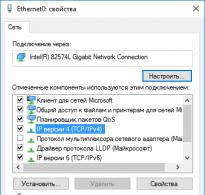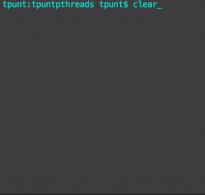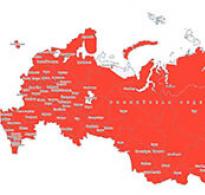How to restart your desktop. How to stop malicious processes? If it's a virus - how to remove it using Registry Editor
A running computer has many processes running simultaneously. The work of most of them occurs unnoticed by the user, and is not externally displayed on the screen. But when setting up a computer or searching for reasons for the operating system to not work correctly, the user is sometimes faced with the need to stop or restart some process.
Instructions
All running processes are divided into those that start automatically at system startup and those that start when the user clicks on a shortcut for a particular program. The first, in turn, are divided into system processes, necessary for the operation of the OS, and user program processes for which the autorun option is installed.
To stop a process, you need to know its name. Open the command line: “Start – All Programs – Accessories – Command Prompt.” Type tasklist and press Enter. You will see a list of processes running on the system. If you cannot determine its identity by the name of the process, use the Everest program. With its help you will receive all the information about your computer, including data about running processes and paths to executable files.
There are several ways to stop the process. The easiest way is through the “Task Manager” (Ctrl + Alt + Del). Select the one you want to stop from the list of processes and right-click on it. In the context menu that opens, select “End process.” Remember that you will not be able to stop critical system processes; the operating system will not allow you to do this.
You can also stop the process from the command line; to do this, enter the command taskkill /pid 1234 /f and press Enter. Instead of “1234”, enter the process identifier (PID), look at it in the last column of the list displayed by the tasklist command. The f parameter in the command specifies the forced termination of the process. To see all the uses of the taskkill command, type taskkill /? at the command prompt. and press Enter.
If you want to stop a running service, open: “Start - Control Panel - Administrative Tools - Services”. Find the service you need and double-click it. In the window that opens, click the “Stop” button, the service will be stopped. Next, you can disable its launch by selecting the “Disable” option in the “Startup Type” menu.
After stopping the service, you can restart it by clicking the Start button. The button is visible if the “Auto” or “Manual” options are selected in the “Startup Type” menu. If Disabled is selected, the button will be disabled.
To start a process that is not a service and, therefore, does not appear in the list of services, find and run its executable file. Look at the path to the file in the Everest program before stopping the process. You can also start the process from the command line - for example, to launch Notepad, type notepad.exe in the command line and press Enter. To run the programs you have installed, you must enter the full path to the executable file.
Attention, TODAY only!
Everything interesting
When working on the Internet, the user is sometimes faced with the situation of uncontrolled traffic consumption. To understand which application uses the Internet, you should use the capabilities of the operating system or special programs. ...
Working on the Internet, especially with a high connection speed, requires compliance with certain security measures. In particular, it is necessary to monitor traffic and prevent uncontrolled network activity on the computer. Instructions 1When connecting...
A computer connected to the Internet is potentially vulnerable to hacker attacks. Every day more and more new virus and Trojan programs are created, so even an antivirus with hourly updated antivirus databases does not guarantee complete…
The task of unloading a process in the Microsoft Windows operating system is a standard procedure and can be solved either using a graphical interface or through a command interpreter. Instructions 1Call the main menu...
Performing the operation of starting a service on a server is a standard procedure in the Microsoft Windows operating system and can be carried out using standard tools in the system itself. No additional software required.…
In the Microsoft Windows operating system, a service is usually called a program designed to provide basic OS capabilities, which runs in the background. Instructions 1Call the main menu of the operating system...
Despite the fairly wide capabilities of the command line utility, calling the main Start menu is not one of them, but the task of launching the selected application from the command line tool can be solved using standard tools...
In the Windows operating system, programs are usually opened through the “All Programs” menu item, using an application shortcut on the desktop, or directly from the program folder by clicking on the executable file. But on Windows there is...
Most computer programs are closed quite traditionally - by selecting the Exit (Quit) option in the menu or by clicking the cross in the upper right corner of the program window. But sometimes there is a need to close a program or “kill” some...
The Windows operating system is installed on millions of computers. When configured correctly, Windows allows you to truly enjoy your work. Over time, the user begins to notice that the computer has not only become slower, but also...
The Windows operating system, with all its undoubted advantages, has one significant drawback. Namely, it is vulnerable to viruses and Trojans. And although antiviruses and firewalls significantly reduce the risk of infection, the user...
There are many programs running on the computer at the same time. If a program uses an Internet connection, it is allocated a specific port. Sometimes the user needs to control which port a particular program is using.…
I encountered a problem that the desktop freezes or does not start at all. What it looks like: the mouse cursor turns into a clock and nothing can be launched from the desktop. The problem exists in both Windows 7 and Windows XP, no difference. Let's figure out how to solve this issue without resorting to heavy artillery.
One-time solution to the problem
You can close the desktop like any program. Only there is no such application in the task manager. But the “explorer.exe” process is responsible for it. We just need to restart this process. For this:
- using the hotkeys “Ctrl + Shift + Esc” or “Ctrl + Alt + Delete” and select “Launch task manager”
- In the task manager window, go to the “Processes” tab and find the “explorer.exe” process there. If there is a lot of stuff there, then just press the letter “e” until you get to it.
- Right-click on the process and select “End Process”.

After this action, the desktop will completely disappear along with the taskbar. Only the background image and the task manager window will remain. If after a few seconds the desktop does not automatically restart, then you need to start it manually. Let's go to the menu “File –> New task”

In the input field we write: explorer

And press “Enter”. With these simple steps you can bring the Windows operating system back to life without having to restart. This whole process is demonstrated in the video below the article. This method is also suitable for Windows 10, but if it does not help, then you need to end the “Desktop Window Manager”.
If your desktop freezes too often
This usually happens after installing some new program. Remember after what actions this started and try to remove the most recently installed programs. If it doesn't help, then roll back to . This could very well be to blame. In this case, let's try to cure the desktop, and for this we need:
- Download the AVZ program. I talked about this program
- Go to "File -> System Restore"", there check the boxes No. "5. Desktop recovery", "16. Recovering the Explorer launch key" and "9. Removing system process debuggers"
- Click the “Perform marked operations” button and reboot.
If the desktop does not start
In cases when the desktop does not load at all and even the “Start” button does not appear, you need to do what is described above, and if that does not help, then something else. Try launching the desktop through the task manager using the method described above. If you don’t have the AVZ program at hand, you’ll have to go into the registry. But I simplified the task for you and prepared a ready-made solution.
Recovering explorer.exe
If when you try to run “explorer.exe” a message appears that such a file was not found, then you will have to restore it. This can be done in three ways.
First way: Enter the command in the New Task window of the Task Manager:
Sfc /scannow
Most likely the program will ask you to insert the Windows installation disc. If it is not there, then the second method may suit you. The program restores damaged and replaced files with original ones. When the program finishes, reboot. By the way, this method can help if the desktop freezes, and the previous tips did not help.
Second way: copy the file “C:\Windows\explorer.exe” from a working machine with the same operating system, or download and unpack my versions:
To put the correct files in a Windows folder without Explorer, enter the command in the New Task window:
copy C:\Downloads\explorer.exe c:\windows
where C:\Downloads is the path to the file, and C:\Windows is the OS installation path.
Before this, you may need to “explorer.exe” as described above.
Third way also requires an installation disk, we will just get the required file from there manually. If the drive has the letter “E:” and the operating system folder is “C:\Windows”, then the procedure is as follows:
- Installing the disc in the tray
- In the already known input field we write:
E:\i386\expand.exe E:\i386\explorer.ex_ C:\windows\explorer.exe
Let's reboot!
Another way is to use Kerish Doctor.
After solving the problem you can.
In the video you can see how to restart the desktop. True, it doesn’t show how I launch the task manager using “Ctrl + Alt + Delete”, because Windows blocks video recording in this mode, but I think everything is clear.
Instructions
All running processes are divided into those that start automatically at system startup and those that start when the user clicks on a shortcut for a particular program. The first, in turn, are divided into system processes, necessary for the operation of the OS, and user program processes for which the autorun option is installed.
To stop a process, you need to know its name. Open the command line: “Start – All Programs – Accessories – Command Prompt.” Type tasklist and press Enter. You will see a list of processes running on the system. If you cannot determine its identity by the name of the process, use the Everest program. With its help you will receive all the information about your computer, including data about running processes and paths to executable files.
There are several ways to stop the process. The easiest way is through the “Task Manager” (Ctrl + Alt + Del). Select the one you want to stop from the list of processes and right-click on it. In the context menu that opens, select “End process.” Remember that you will not be able to stop critical system processes; the operating system will not allow you to do this.
You can also stop the process from the command line; to do this, enter the command taskkill /pid 1234 /f and press Enter. Instead of “1234”, enter the process identifier (PID), look at it in the last column of the list displayed by the tasklist command. The f parameter in the command specifies the forced termination of the process. To see all the uses of the taskkill command, type taskkill /? at the command prompt. and press Enter.
If you want to stop a running service, open: “Start - Control Panel - Administrative Tools - Services”. Find the service you need and double-click it. In the window that opens, click the “Stop” button, the service will be stopped. Next, you can disable its launch by selecting the “Disable” option in the “Startup Type” menu.
After stopping the service, you can restart it by clicking the Start button. The button is visible if the “Auto” or “Manual” options are selected in the “Startup Type” menu. If Disabled is selected, the button will be disabled.
To start a process that is not a service and, therefore, does not appear in the list of services, find and run its executable file. Look at the path to the file in the Everest program before stopping the process. You can also start the process from the command line - for example, to launch Notepad, type notepad.exe in the command line and press Enter. To run the programs you have installed, you must enter the full path to the executable file.
If, when you turn on the system, just one explorer.exe file does not automatically start, then instead of the usual screen image you will see a black screen with a mouse arrow. This is because explorer.exe is one of the main Windows processes. More information about the file, errors and solutions later in the article.
What is explorer.exe and what is it for?
Explorer.exe is an executable file that launches the Windows graphical shell. In other words, this is the entire main interface of the system. If explorer.exe does not automatically load when you turn on the system, you will not see the desktop, start, or file manager.
What problems and errors may be associated with starting the process
There are many errors associated with this system file:
- "Explorer.exe Application Error."
- "Explorer.exe is not a Win32 application."
- “An error has occurred in the Explorer.exe application. The application will be closed. We apologize for the inconvenience."
- "The file explorer.exe was not found."
- "Explorer.exe not found."
- "Error starting program: explorer.exe."
- "Explorer.exe is not running."
- "Explorer.exe has failed."
- "Faulting Application Path: explorer.exe."
This can happen when you turn your computer on and off, when you reinstall the OS, or when you install or run a program that is associated with explorer.exe.
There are 3 reasons for the error in this system file.
- Virus software. Viruses delete files, change them, and cause the system to crash. In the case of the explorer.exe file, things are even more interesting. To remain undetected in the system, viruses use system file names that do not arouse suspicion. Since explorer.exe is required to be on Windows, this is a great option.
- The program was installed on the computer with errors or was installed incorrectly. Or a program is installed that conflicts with the file, which could mistakenly delete data necessary for explorer.exe to function correctly.
- There may be an error in the file itself.
What to do if the process does not start automatically
How to check in Windows safe mode why explorer.exe does not start
First of all, you should check whether the automatic download failure is caused by viruses. To do this, start Windows in safe mode. Safe mode is a system boot with a minimum set of components. Therefore, nothing will interfere with an accurate check. There are two ways to enter safe mode. First:
Second way:

In safe mode, we check how the system works. If the download occurred normally, then autorun is blocked by a recently installed program or virus.
Run a full system scan with your antivirus without leaving safe mode. Remove all detected threats.
System Restore as a way to restart the process
The operating system itself creates recovery checkpoints. This happens either as planned, with a certain frequency, or after major changes. In the event of a failure, this allows you to “roll back” the system to that point and restore correct operation. There are several ways to roll back the system; do this using the System Restore Wizard.
System Restore does not delete or affect personal files in any way. But it removes all programs and drivers installed after the selected checkpoint, and changes in them (activation, updates, etc.).
Where is it located and how to launch it - step by step steps
- Click “Start” and enter the word “Recovery” in the search bar.
- Select System Restore.
- In the new window that appears, click “Next”.
- Select a restore point, it’s easier to navigate by date. To see more information, enable “Show other restore points” and click “Search for affected programs.”
- We confirm the restoration - click “Finish”.
How to scan and restore interface loading using the command line
This method corrects errors in the file itself. To do this we will need administrator rights.

If it's a virus - how to remove it using Registry Editor

Despite the fact that this file provides the ability to communicate with a computer, there are often tips to stop or restart explorer.exe. Under no circumstances should this be done. To troubleshoot problems, use one of the methods described above.
Explorer in Windows is almost the complete system interface; it includes running windows, open folders, desktop, and so on. Explorer is a process called explorer.exe, which may freeze or malfunction and require a restart. Most often, users do this by completely restarting the computer, but you can only restart Explorer, which is much faster and no less simple. In this case, restarting the explorer may also be necessary, for example, to activate changes made to the system registry and in a number of other cases.
How to restart File Explorer in Windows
There are several ways to restart File Explorer in the Windows operating system. The simplest of them, which is available on any version of the operating system, is to deactivate the explorer.exe process through the Task Manager. This is done as follows:

There are also other ways to restart Explorer in Windows:

It is worth noting that in some cases, after the Explorer is completed, it starts automatically, and its forced activation through the task manager is not required. But if, after performing the steps described above, the conductor is turned off and does not turn on on its own, below we will talk about how to start it.
How to start File Explorer on Windows
When the Explorer process ends, all elements of the system disappear, while the user remains able to use various Windows utilities, including the Task Manager. Through it you can launch Explorer as follows:

If Explorer on the system does not start after the computer boots, and attempts to start it using the method described above by creating a new task result in errors, you can try the following:
- Through the “Task Manager”, launch a new task - rstrui.exe;
- Also try running the command line through the Task Manager by activating the cmd.exe task. When the command prompt is launched, check the integrity of the system files of the Windows operating system by entering sfc /scannow at the command line.
If the tips above do not help you start Windows Explorer, you can try restoring your computer to the last checkpoint or resetting the operating system, but this will require a bootable USB flash drive or disk.






